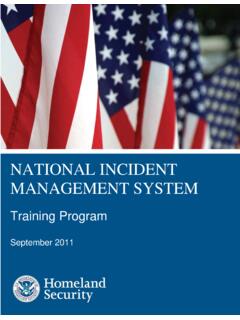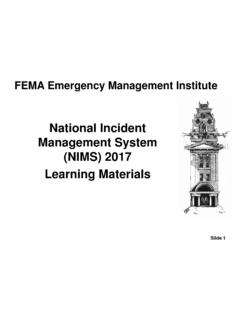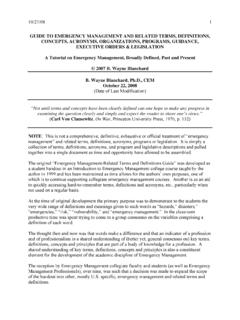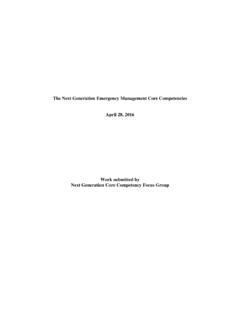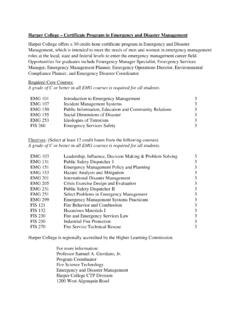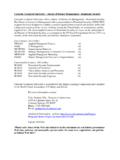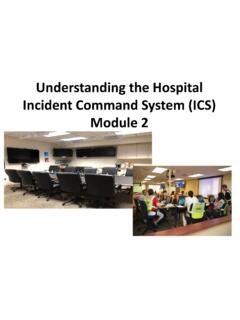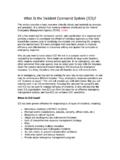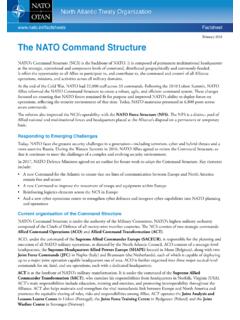Transcription of ICS Organizational Structure and Elements
1 ICS Organizational Structure and Elements EXTRACTED FROM - E/L/G 0300 INTERMEDIATE INCIDENT command SYSTEM FOR EXPANDING. INCIDENTS, ICS 300. March 2018 ICS Organizational Structure and Elements EXTRACTED FROM - E/L/G 0300. Intermediate Incident command System for Expanding Incidents, ICS 300. ICS Organizational Structure and Elements command Staff: The staff who report directly to the Incident Commander, including the Public Information Officer, Safety Officer, Liaison Officer, and other positions as required. Section: The Organizational level having responsibility for a major functional area of incident management ( , Operations, Planning, Logistics, Finance/Administration, and Intelligence/Investigations (if established)).
2 The Section is organizationally situated between the Branch and the Incident command . Branch: The Organizational level having functional and/or geographical responsibility for major aspects of incident operations. A Branch is organizationally situated between the Section Chief and the Division or Group in the Operations Section, and between the Section and Units in the Logistics Section. Branches are identified by the use of Roman numerals or by functional area. Division: The Organizational level having responsibility for operations within a defined geographic area. The Division level is organizationally between the Strike Team and the Branch. Group: An Organizational subdivision established to divide the incident management Structure into functional areas of operation.
3 Groups are located between Branches (when activated) and resources (personnel, equipment, teams, supplies, and facilities) in the Operations Section. 2. March 2018 ICS Organizational Structure and Elements EXTRACTED FROM - E/L/G 0300. Intermediate Incident command System for Expanding Incidents, ICS 300. Unit: The Organizational element with functional responsibility for a specific incident planning, logistics, or finance/administration activity. Task Force: Any combination of resources assembled to support a specific mission or operational need. A Task Force will contain resources of different kinds and types, All resource Elements within a Task Force must have common communications and a designated leader.
4 Strike Team/ Resource Team: A set number of resources of the same kind and type that have an established minimum number of personnel, common communications, and a designated leader. In the law enforcement community, Strike Teams are sometimes referred to as Resource Teams. Single Resource: An individual, a piece of equipment and its personnel complement, or a crew/team of individuals with an identified work supervisor that can be used on an incident. Overall Organizational Functions ICS was designed by identifying the primary activities or functions necessary to effectively respond to incidents. Analyses of incident reports and review of military organizations were all used in ICS development.
5 These analyses identified the primary needs of incidents. As incidents became more complex, difficult, and expensive, the need for an Organizational manager became more evident. Thus, in ICS, and especially in larger incidents, the Incident Commander manages the organization and not the incident. In addition to the command function, other desired functions and activities were to: Delegate authority and provide a separate Organizational level within the ICS. Structure with sole responsibility for the tactical direction and control of resources. Provide logistical support to the incident organization. Provide planning services for both current and future activities.
6 Provide cost assessment, time recording, and procurement control necessary to support the incident and the managing of claims. Promptly and effectively interact with the media, and provide informational services for the incident, involved agencies, and the public. Provide a safe operating environment within all parts of the incident organization. Ensure that assisting and cooperating agencies' needs are met, and to see that they are used in an effective manner. 3. March 2018 ICS Organizational Structure and Elements EXTRACTED FROM - E/L/G 0300. Intermediate Incident command System for Expanding Incidents, ICS 300. ICS Who Does What? Incident Commander The Incident Commander is technically not a part of either the General or command Staff.
7 The Incident Commander is responsible for: Having clear authority and knowing agency policy. Ensuring incident safety. Establishing an Incident command Post. Setting priorities, and determining incident objectives and strategies to be followed. Establishing the ICS organization needed to manage the incident. Approving the Incident Action Plan. Coordinating command and General Staff activities. Approving resource requests and use of volunteers and auxiliary personnel. Ensuring after-action reports are completed. Authorizing information release to the media. Ordering demobilization as needed. 4. March 2018 ICS Organizational Structure and Elements EXTRACTED FROM - E/L/G 0300.
8 Intermediate Incident command System for Expanding Incidents, ICS 300. Incident Management Team An Incident Management Team (IMT) is a rostered group of ICS-qualified personnel consisting of an Incident Commander, command and General Staff, and personnel assigned to other key ICS positions. The level of training and experience of the IMT. members, coupled with the identified formal response requirements and responsibilities of the IMT, are factors in determining type, or level, of IMT. command Staff The command Staff is assigned to carry out staff functions needed to support the Incident Commander. These functions include interagency liaison, incident safety, and public information.
9 command Staff positions are established to assign responsibility for key activities not specifically identified in the General Staff functional Elements . These positions may include the Public Information Officer (PIO), Safety Officer (SO), and Liaison Officer (LNO), in addition to various others, as required and assigned by the Incident Commander. General Staff The General Staff represents and is responsible for the functional aspects of the Incident command Structure . The General Staff typically consists of the Operations, Planning, Logistics, and Finance/Administration Sections. In some incidents the General Staff may also include the Intelligence/Investigations Function, either operating under a staff section, or as a stand alone section.
10 General guidelines related to General Staff positions include the following: Only one person will be designated to lead each General Staff position. General Staff positions may be filled by qualified persons from any agency or jurisdiction. Members of the General Staff report directly to the Incident Commander. If a General Staff position is not activated, the Incident Commander will have responsibility for that functional activity. Deputy positions may be established for each of the General Staff positions. Deputies are individuals fully qualified to fill the primary position. Deputies can be designated from other jurisdictions or agencies, as appropriate.
